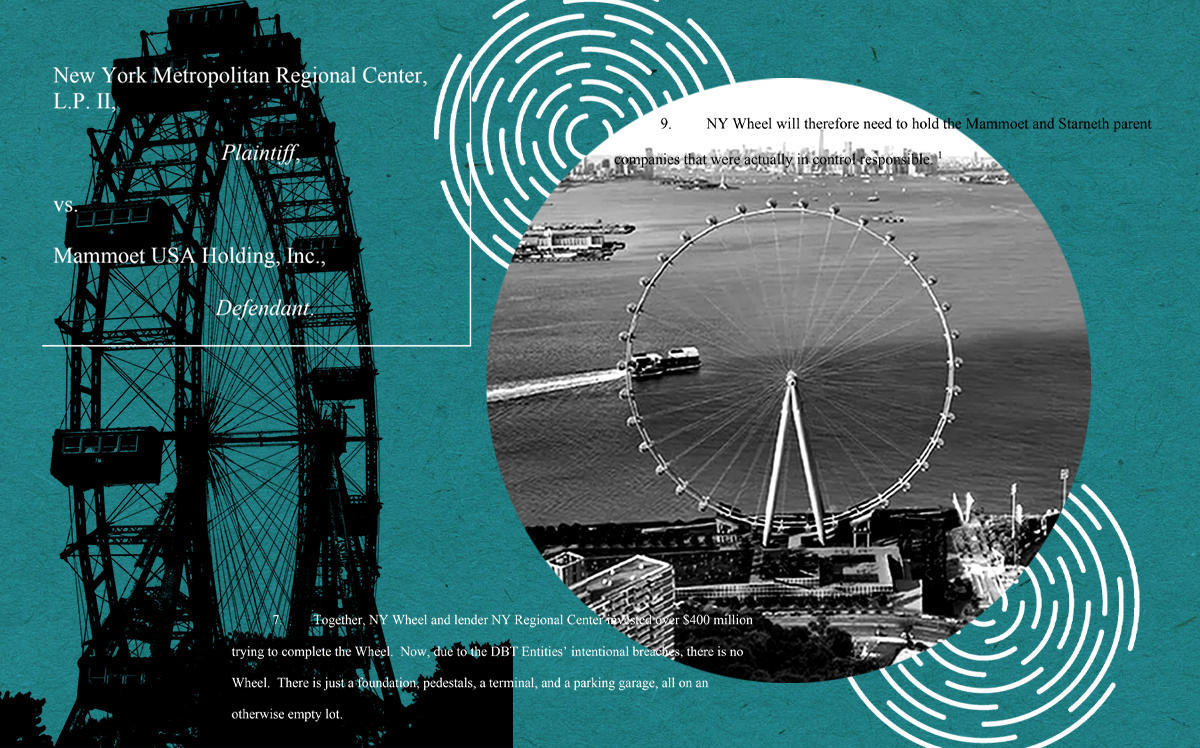The New York Wheel, the Staten Island waterfront project that would have been the largest observation wheel in the world, was declared dead two years ago. But legal wrangling over who is responsible for the project’s failure is far from over.
Last week, lawyers for both the project’s developer and contractor filed new lawsuits in federal and state court, respectively, after coming to the “unfortunate realization” that a prior suit, dating back to 2017, should not have been filed in federal court to begin with.
The problem, as laid out in a joint letter from both sides to the court, stems from a somewhat obscure “jurisdictional defect.” The group of investors behind the New York Wheel includes two minority members who primarily reside in Florida and California — which also happens to be where the project’s two Dutch contractors, Mammoet and Starneth, are located.
Lawyers with Dovel & Luner, who are now representing both the Wheel’s developers and the EB-5 regional center behind the project, CanAm Enterprises, say they only recently discovered this issue because they had relied on the analysis of their predecessors at first.
“As it turned out, this reliance was a serious mistake, as the prior analysis has now been shown to have been incomplete and inaccurate,” they wrote in the joint letter, noting that “no effort was made to withhold the truth or game the system.”
On Wednesday, Dovel & Luner filed a new suit in the Southern District of New York, with only CanAm — and not the developer — as plaintiff. Lawyers for Mammoet filed a suit of their own in New York State Supreme Court on the same day, seeking to move the entire dispute to a new venue. The three-year-old lawsuit, which was dismissed once in 2018 and re-opened in 2019, was dismissed again on Friday.
“We are confident that the NY Regional [i.e. CanAm] claim belongs in federal court and believe that any proceedings in state court should be deferred until after the federal court resolves the [CanAm] claim,” Jeff Eichmann of Dovel & Luner told The Real Deal in an email.
“Regardless of which courts preside over the various claims and counterclaims, NY Wheel [the developer] and [CanAm] are determined to hold the Defendants accountable for their breaches and recover the full measure of damages they are entitled to,” he added.
Counsel for Mammoet did not respond to a request for comment.
Read more



Allegations in the two new lawsuits, which mostly repeat claims made in the original 2017 suit, paint starkly different pictures of the circumstances that led to the New York Wheel’s demise.
In the developer and CanAm’s view, the story is simple: Mammoet and Starneth agreed to a fixed-price contract for the project, and if there were cost overruns, that was on them. “Due to their lack of diligence, they vastly underestimated how much it would cost them to build the Wheel,” CanAm’s new complaint says.
“The [contractors] eventually concluded that if they honored the contract, they would lose too much money. And so they tried to change the contract or escape it” — first by overcharging on their payment applications, and eventually by walking off altogether, the suit claims.
Mammoet, for its part, claims that it was the developers who did not live up to their numerous obligations. (Mammoet’s partner, observation wheel specialist Starneth, is currently in bankruptcy and not party to the new lawsuits.)
“[NY Wheel]’s refusal to acknowledge its contractual obligations, coupled with the fact that [NY Wheel] never invested the time or money to properly and adequately supervise, manage or finance the project, doomed the project from the outset,” Mammoet’s complaint states.
According to the contractor, the developer’s breaches of contract include supplying a construction site “with insufficient ground bearing capacity” and a foundation for the Wheel that was “inconsistent, unequal and excessive in its lateral stiffness,” as well as failing to secure a building permit.
The contractor entity that was working on the Wheel, Mammoet-Starneth LLC, declared bankruptcy in late 2017, and the parties came to a conditional settlement a few months later which led to the case being closed.
But that settlement depended on the developers’ ability “to obtain financing to complete the Wheel with its alternative builder,” which did not pan out, court filings show. The wheel’s parts were eventually sold at auction, and the developers re-opened the suit in August 2019, adding CanAm as a plaintiff in the process.
